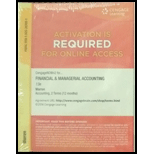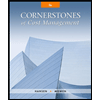
1.
Sales mix: It refers to the relative distribution of the total sales among the number of products sold by a company. In other words, it is expressed as a percentage of units sold for each product with respect to the total units sold for all the products.
Break-even Point: It refers to a point in the level of operations at which a company experiences its revenues generated is equal to its costs incurred. Thus, when a company reaches at its break-even point, it reports neither an income nor a loss from operations. The formula to calculate the break-even point in sales units is as follows:
the break-even point in sales units for the overall Product E for the current year.
1.
Explanation of Solution
Determine the break-even point in sales units for the overall Product E.
Fixed cost =$2,498,600
Contribution margin per unit =$620 per unit (3)
Working notes:
Note: For break-even analysis, the Product-Laptops and Product-Tablets are considered as the components of one overall company’s Product E.
Determine the selling price per unit of Product E.
Determine the variable cost per unit of Product E.
Determine the unit contribution margin of Product E.
Therefore, the break-even point in sales units for the overall Product E for the current year is 4,030 units.
2.
the break-even sales (units) for Product-Laptops and Product-Tablets.
2.
Explanation of Solution
Determine the break-even point in sales units:
For Product-Laptops
Break-even point in sales units for Product E =4,030 units (refer Part a)
Sales Mix for Product Laptops =40%
For Product-Tablets
Break-even point in sales units for Product E =4,030 units (refer Part a)
Sales Mix for Product Tablets =60%
Therefore, the break-even point in sales units for the Product Laptops is 1,612 units and for the Product Tablets is 2,418 units.
3.
To compare: the break-even point with that in Part (1).
3.
Explanation of Solution
The break-even point calculated in (1) with a sales mix of 50% laptops and 50% tablets is 3,844 units. It is less than the break-even point of 4,030 units calculated in Part 1.
The reason for the difference is the sales mix which is allocated at a higher percentage to the laptops (50%) and tablets (50%) in the present case. It resulted in the higher contribution margin per unit of $650 per unit than in Part 1 ($620 per unit). Thus, it decreases the break-even point of sales (units) in the present case.
Working notes:
Determine the break-even point in sales units for the overall Product E.
Fixed cost =$2,498,600
Contribution margin per unit =$620 per unit (7)
Note: For break-even analysis, the Product-Laptops and Product-Tablets are considered as the components of one overall company’s Product E.
Determine the selling price per unit of Product E.
Determine the variable cost per unit of Product E.
Determine the unit contribution margin of Product E.
Determine the break-even point in sales units:
For Product-Laptops
Break-even point in sales units for Product E =3,844 units (4)
Sales Mix for Product Laptops =50%
For Product-Tablets
Break-even point in sales units for Product E =3,844 units (4)
Sales Mix for Product Tablets =50%
Want to see more full solutions like this?
Chapter 19 Solutions
CengageNOWv2, 2 terms Printed Access Card for Warren?s Financial & Managerial Accounting, 13th, 13th Edition
- I am trying to find the accurate solution to this general accounting problem with appropriate explanations.arrow_forwardI need help with this general accounting question using standard accounting techniques.arrow_forwardI am looking for a reliable way to solve this financial accounting problem using accurate principles.arrow_forward
- I need help with this general accounting problem using proper accounting guidelines.arrow_forwardPlease explain the solution to this general accounting problem using the correct accounting principles.arrow_forwardCan you help me solve this general accounting question using the correct accounting procedures?arrow_forward
- Horngren's Financial & Managerial Accounting: The Managerial Chapters, 8th Edition. E-M:9-14 Describing the balanced scorecard and identifying key performance indicators for each perspectiveConsider the following key performance indicators and classify each indicator according to the balanced scorecard perspective it addresses. Choose from the financial perspective, customer perspective, internal business perspective, and the learning and growth perspective. a.Number of customer complaintsb.Number of information system upgrades completedc.Residual incomed.New product development timee.Employee turnover ratef.Percentage of products with online help manualsg.Customer retentionh.Percentage of compensation based on performancei.Percentage of orders filled each weekj.Gross margin growthk.Number of new patentsl.Employee satisfaction ratingsm.Manufacturing cycle time (average length of production process)n.Earnings growtho.Average machine setup timep.Number of new customersq.Employee…arrow_forwardDo fast answer of this general accounting questionarrow_forwardPlease provide the solution to this general accounting question with accurate accounting calculations.arrow_forward
 Managerial AccountingAccountingISBN:9781337912020Author:Carl Warren, Ph.d. Cma William B. TaylerPublisher:South-Western College Pub
Managerial AccountingAccountingISBN:9781337912020Author:Carl Warren, Ph.d. Cma William B. TaylerPublisher:South-Western College Pub Cornerstones of Cost Management (Cornerstones Ser...AccountingISBN:9781305970663Author:Don R. Hansen, Maryanne M. MowenPublisher:Cengage Learning
Cornerstones of Cost Management (Cornerstones Ser...AccountingISBN:9781305970663Author:Don R. Hansen, Maryanne M. MowenPublisher:Cengage Learning Survey of Accounting (Accounting I)AccountingISBN:9781305961883Author:Carl WarrenPublisher:Cengage Learning
Survey of Accounting (Accounting I)AccountingISBN:9781305961883Author:Carl WarrenPublisher:Cengage Learning Managerial Accounting: The Cornerstone of Busines...AccountingISBN:9781337115773Author:Maryanne M. Mowen, Don R. Hansen, Dan L. HeitgerPublisher:Cengage Learning
Managerial Accounting: The Cornerstone of Busines...AccountingISBN:9781337115773Author:Maryanne M. Mowen, Don R. Hansen, Dan L. HeitgerPublisher:Cengage Learning Financial And Managerial AccountingAccountingISBN:9781337902663Author:WARREN, Carl S.Publisher:Cengage Learning,
Financial And Managerial AccountingAccountingISBN:9781337902663Author:WARREN, Carl S.Publisher:Cengage Learning,




